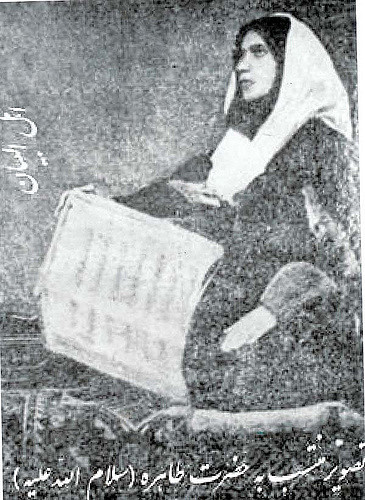
A Muslim woman's task in life is to take care of, and obey, her husband and not leave her home without his permission. Therefore, there is no need to teach her to read and write, let alone mathematics, astronomy and physics.
RELIGIOUS LEADERS have continued their intransigence towards women’s education to this day. The Saudi Shaykh ibn Ḥumayd issued the following fatwā:
I wish to draw the attention of the rulers to the fact that there is no objection to expanding the scope of women’s education on the curriculum as approved by religion and its teachings, provided they maintain the ḥijāb and conserve virtuous morals. There was education for women at the time of the righteous predecessors, such as the teaching of tawḥīd, purity, prayer, the rulings concerning menstruation, postpartum, and obligatory religious matters pertaining to them, how to raise their children, manage their homes, and other things that are beneficial to them. This is what we perceive to be the goal of the government, the aims of which may God support.
They thus entrusted education to the shaykhs and they appointed one of their own to head it, in the hope of directing the course taken by girls’ schools towards their desired goal. Unfortunately, in the first year, things appeared to have changed and the situation went wrong for them.
The Al-Bilād newspaper (issue no. 703 dated 3/12/1380 AH) published an article by the aforementioned head featuring his intention to introduce the subjects of arithmetic, engineering and geography in the curricula of girls’ schools for the following school year, since these subjects were not taught that year. It ran:
O Muslims: O people of pride and honour, listen to this heinous statement intended to force decent people, in the cause of keeping up with dissolute nations, to have their daughters taught arithmetic, geometry and geography. What do women have to do with these sciences, along with more than eleven other – mostly useless – studies? This is a disaster, a great danger to our society![1]
Did this great shaykh not understand the hadith with which Islamists defend Islam and which obligated the acquisition of knowledge for every Muslim man and woman, when the Prophet of Islam said: “Seek ye knowledge, even unto China”? This fatwā from Shaykh ibn Ḥumayd proves that the knowledge in question is no more than the memorization of the Qur’ān and the hadiths.
There is a continued intransigence towards women’s education
Such upbringing can only produce sheep that follow the shepherd wherever it goes, veiling the mind. It is for this reason that Islamic history cannot cite us any woman famed for science except for Qurrat al-‘Ayn who was born in Ghazvin in 1814 and became famous for her beauty, her superior intelligence and her comprehensive knowledge of the Qur’ān and the Hadith. She outstripped the men of her time, as the Iraqi scholar Alī al-Wardī says:
Many of those who knew and heard her at various times in her life always recalled that in addition to her famed scholarship and rhetorical eloquence, her delivery was deceptively easy but contained hidden depth, and that those listening to her speech were shaken to the depths of their hearts, and so full of admiration that they were reduced to tears.
Could the clerics of the time allow such a woman to excel in scholarship and public speaking? Of course they could not, and therefore, as ‘Alī al-Wardī explains:
she was tied by her hair to the tail of a mule and dragged to court, where she was sentenced to be burned alive. However, the government ordered that this burning should be delayed to after her death, so she was strangled and then her body was thrown into the fire.
The rest of Arab women are mentioned by historians not for their knowledge but for their beauty or when they refused to wear the ḥijāb. Historians say that ‘Ā’isha bint Ṭalḥa ibn ‘Ubayd Allah, the wife of Muṣ‘ab ibn al-Zubayr ibn al-‘Awwām – whom ‘Umar ibn ‘Abdullah married after Muṣ‘ab’s death – said that she refused to wear the ḥijāb despite the insistence of her husbands (she was married three times)[2] and that she was so beautiful, and with such shapely buttocks that women used to write odes about them.[3] Al-Dhahabī said of her in his Biography of Nobles that “she was the most beautiful and most prominent woman of her time, and her hadith is cited in the Ṣaḥīḥ collections). Like Qurrat al-‘Ayn, her distinction was solely in the religious sciences.
Biographical works tell us also about ‘Ā’isha bint Abī Bakr, who excelled men in narrating hadith and in memorizing the Qur’an, no surprise given that she was the wife of Muḥammad, the author of both. The biographers speak of other Muslim women who fought in the ranks of Muslim armies against the Romans, and of women who defended Muḥammad at the battle of Uhud even while ‘Umar and ‘Uthmān ibn ‘Affān had fled.
With the beginning of the ‘Abbāsid state women became famous for singing and dancing in the palaces of the Abbāsid caliphs. However, although under al-Ma’mūn the state was open to translation and the natural sciences, no woman was known for science or literature. The Ottoman Caliphate built harem quarters in the palaces of the sultans, and Sultan Abdul Hamid issued a decree stipulating that any woman who leaves her house without the ḥijāb and the khimār should have her hair cut and then placed on a donkey to go round the village with her head facing towards the donkey’s tail.
Muslim women have become the fiercest defenders of the very Islam which humiliates them
Even in our time, we are yet to hear of an Arab woman known internationally in the scientific field, other than Mrs. Zaha Hadid, the Iraqi architect who has designed some famous buildings in Europe, America and the Gulf countries. Despite the spread of university education for women in the Arab world, the shaykhs still stand against them and prevent them from being sent abroad to obtain postgraduate studies. In Saudi Arabia, a female doctor is only allowed to specialize in obstetrics, gynaecology and pediatrics. Some female doctors in Saudi Arabia still wear the veil so that the patient can only see her eyes.
Even when women are allowed to be educated, instead of finding encouragement from their male colleagues and any help to gain the highest professions, we find, for instance, Egyptian judges protesting against the appointment of women to the Supreme Court because the Qur’ān says that Men are in charge of women[4] and women therefore should not be Supreme Court judges that would mean that they would be higher than most male judges.
Prince Nayif ibn ‘Abd al-‘Azīz said in his speech at the inauguration of the Saudi Shura Council that he did not see the need for women to be present in the Council.[5] In a country where rulers, shaykhs and educated people behave with such contempt for women, its women can only join their sisters in developed countries if international organizations and Western governments put pressure on our dictators to restrain the clergy, who are the rulers’ apparatus for subordinating their citizens.
King Abdullah ibn Sa‘ūd proved this when he established the new Thuwal University and allowed men and women to study together there. Only two or three shaykhs voiced their opposition to this and when they lost their jobs the others fell as silent as the grave. For these, religion is a business they earn their living from.

Suggested Reading
The second solution is for women to rebel against these restrictions, just as European and American women came out for their rights to vote in elections and be represented in parliaments. Unfortunately, the brainwashing that Muslim women have been subjected to since the day they were born has made rebellion a solution that cannot happen, since the shaykhs have turned oppressed women into the fiercest defenders of the very Islam which humiliates them.
The last and most difficult solution is the revolt of the Arab people in the cause of implementing democracy, something which they seem at present to fear as much as their rulers, because Islam requires that Muslim blindly obeys the ruler, ‘even if he strikes his back and steals his wealth.’ [6] The shaykhs have taught them that democracy is just as blasphemous as communism. I believe that Muslim women, whether Arab or foreign, will continue to stumble about in their black tents for quite some time. I can only say: may Astarte help them!
[1] From الدرر السنية Vol. 16 pp.79-84, cited on the أنا المسلم network.
[2] Ā’isha bint Ṭalḥa is famous for arguing to a Companion that “Since the Almighty hath put on me the stamp of beauty, it is my wish that the public should view the beauty and thereby recognise His grace unto them. On no account, therefore, will I veil myself.” (Ed.)
[3] See Abū al-Faraj al-Iṣfahānī’s كتاب الأغاني (‘Book of Songs’) in the entry on ‘Ā’isha bint Ṭalḥa.
[4] Qur’ān IV (al-Nisā’), 34: Men are in charge of women, because Allah hath made the one of them to excel the other.
[5] Al-Sharq al-Awsaṭ, 25 March 2009.
[6] Cf. Ṣaḥīḥ Muslim, 1847: تَسْمَعُ وَتُطِيعُ لِلْأَمِيرِ وَإِنْ ضُرِبَ ظَهْرُكَ وَأُخِذَ مَالُكَ فَاسْمَعْ وَأَطِعْ You should listen and obey them even if the ruler strikes your back and takes your wealth, even still listen and obey.
See Part One of this essay here

